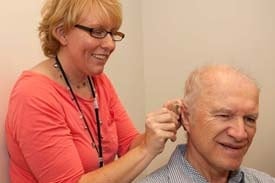Cleveland Hearing & Speech Center audiologists are highly trained professionals. We have Doctoral and Master’s degrees in audiology and we have devoted our careers to helping you hear better. At CHSC, We believe that life is improved by successful communication. We are dedicated to helping people hear better so they can fully enjoy the people and activities that bring meaning to each day.
Buying Hearing Aids: CHSC Audiologists vs. Online or Over the Counter
Tags: Hearing Aid, Audiology, Hearing Aids, Communication, Support, Hard of Hearing, Hearing Loss
Yanny or Laurel? It's your brain not your ears that decides
As a speech scientist, I never thought I’d see so much excitement on social media about one tiny little word.
Tags: Speech, Language, Communication
Social & Communication Skills in Children
Social skills are the ways we use our language skills in social situations. Social communication is important in developing effective interpersonal skills and is critical to various aspects of our daily life. Social skills are important in childhood and adulthood. What is the relationship between social skills and speech-language skills/disorders?
Tags: Speech, Language, Communication, Learning, Voice
Children's Language Disorders & Treatments
Tags: Speech, Language, Communication, Learning, Voice
What is Language - and How Does It Develop?
Language is the basis for all learning. Children first learn to communicate through eye contact, crying, vocalizing and gesturing. As they grow, they learn the language around them. Children then learn about their world through language by talking, playing and reading; parents and teachers use various forms of language to help children learn. Later, children learn about language as they grow older.
Tags: Speech, Language, Communication, Hearing, Learning, Voice
Augmentative/Alternative Communication and Speech-Generating Devices
Sometimes, despite what speech therapy can offer and how hard you may try to improve or regain your verbal communication skills, you may need to consider other options. Modern technological advances have brought about many improvements in devices that can supplement or augment your communication skills. There are simple items and more sophisticated computerized tools as well. These tools are referred to collectively as Augmentative/Alternative Communication (AAC) devices. Some devices speak for you and are called speech-generating devices (SGD).
Tags: Speech, Language, Communication, Voice
Top 10 Tips for a Healthy Voice
- Try not to shout or scream.
- Decrease your volume – try not to repeatedly yell over others in noisy environments (e.g., restaurants, sporting events or other crowded locations).
- Try to eliminate background noise when talking.
- If you overuse your voice, take time for vocal rest by drinking lots of fluids and decreasing the amount of talking you do that day.
- When possible, use an amplification device or microphone when speaking in front of groups for long periods of time.
- Drink water to keep your vocal cords hydrated and healthy! If your vocal cords are dehydrated, they are more easily damaged and do not perform as well.
- Avoid clearing your throat or coughing repeatedly.
- Avoid excessive use of alcohol, caffeine, and tobacco.
- Warm up your voice before talking for a long period of time. Practice saying a sound such as “ah” going from low to high pitch and high to low pitch.
- Use good breath support. Try to breathe naturally and avoid holding your breath while speaking.
Tags: Speech, Communication, Support, Voice
Voice Problems and How to Improve Them
How do we produce voice?
The sound of your voice is affected by the size and shape of your larynx, throat and mouth. Abnormalities in the size and shape of these structures or with the airway (trachea) can affect voice quality. Voice problems can be the result of trauma as well.
To produce voice, air is drawn into the lungs, usually through the nose. The lungs expand when they fill with air, and then we gradually release the air through the trachea and mouth. We control the flow of air with muscles of the diaphragm, ribcage and larynx (voice box). As air passes through the trachea, it passes between the vocal folds. Just after we breathe air in, muscles in the larynx close the vocal folds to help keep the air in the lungs. As air pressure builds, the air pushes against the vocal folds, causing them to open. The interaction of muscle tension (closing the vocal folds) and air pressure (opening the vocal folds) causes a vibration of the vocal folds. This vibration creates sound. That sound is shaped by the size and shape of our vocal folds, throat (pharynx) and mouth.
Phonation refers to the production of voice. Each person’s voice is unique to him or her. Our voices are as identifiable as a fingerprint. The first voiced sound we often hear from an infant is a cry. Generally, in infancy, cries can be differentiated and parents learn the meanings of different cries for hunger, pain/discomfort, etc. As infants grow, they begin to coo, exploring the use of their voices and learning what sounds they can make. Eventually, by listening to others and decoding the language around them, they begin to shape their voices by producing various vowels and consonants that initially make up babble and “baby-talk” and later become real words. Find our speech development chart for children ages 0-5 years here.
What are some common voice problems?
There are certain voice problems associated with congenital problems with the airway or central nervous system. Other voice problems are associated with the structures of the mouth, nose and other structures in the throat such as tonsils and adenoids. Still other voice problems are the result of misuse of the voice.
When the airway is compromised or obstructed, a child may not be able to produce voice (phonate). Oftentimes, these problems require surgery. This is also true of problems with the larynx itself. Vocal fold paralysis accounts for 10 percent of all laryngeal problems. One or both vocal folds can be paralyzed. This paralysis is typically the result of damage or lesion to the nerves that stimulate the muscles of the larynx to move and is considered a problem of the central nervous system. Unilateral (one-sided) vocal fold paralysis can sometimes be managed with surgery. There are also devices that can be used to generate sound when the vocal folds cannot.
Children sometimes develop problems with voice without any type of physical or neurological problems. Like adults, children can develop vocal nodules (small bumps on the vocal folds) that make the voice hoarse or breathy. Misusing the voice by talking in an unnatural manner, screaming harshly or making certain noises such as truck and car sounds can lead to changes in voice quality. This in turn can affect how easy or difficult it is to understand what the child says.
Tags: Speech, Language, Communication, Voice
5 Myths About Stuttering
Myth: People who stutter are not smart.
Reality: There is no link whatsoever between stuttering and intelligence.
Myth: Nervousness causes stuttering.
Reality: Nervousness does not cause stuttering. Nor should we assume that people who stutter are prone to be nervous, fearful, anxious or shy. They have the same full range of personality traits as those who do not stutter.
Myth: Stuttering can be "caught" through imitation or by hearing another person stutter.
Reality: You can't "catch" stuttering. No one knows the exact causes of stuttering, but recent research indicates that family history (genetics), neuromuscular development and the child's environment, including family dynamics, all play a role in the onset of stuttering.
Myth: It helps to tell a person to "take a deep breath before talking," or "think about what you want to say first."
Reality: This advice only makes a person more self-conscious, making the stuttering worse. More helpful responses include listening patiently and modeling slow and clear speech yourself.
Myth: Stress causes stuttering.
Reality: As mentioned above, many complex factors are involved. Stress is not the cause, but it certainly can aggravate stuttering.
Famous people who stutter
James Earl Jones, John Stossel, Bill Walton, Mel Tillis, Winston Churchill, Marilyn Monroe, Carly Simon, Annie Glenn, Nicholas Brendon, Ken Venturi, Bob Love, John Updike, King George VI all stuttered and went on to have successful lives.
Tags: Speech, Communication, Stuttering
Stuttering Therapy for Children
Stuttering can become a lifelong part of talking for some people. However, it does not have to interfere with your child's ability to make friends, participate in the classroom, make good grades, form lasting relationships or achieve career goals.
Deciding whether to take your child to speech therapy can be a difficult decision, however, many parents are concerned that taking a child to therapy will increase his or her awareness of the stuttering and thus have a negative effect or are unsure about the best time to start their child in therapy, especially when they get conflicting advice about whether to "wait and see" versus take action. Adding to the confusion, research suggests that as many as 70 percent of all children who start stuttering will outgrow it on their own with no speech therapy. But research also indicates that if a child has been stuttering longer than a year, the likelihood that he or she will outgrow it without any speech therapy is reduced.
Unfortunately, there are no firm guidelines about the best time to start therapy, although most speech-language pathologists will recommend starting therapy within six to 12 months after you have first noticed the stuttering. One thing we do know, though, is that all children can benefit from therapy, although the outcomes are different for different children.
As a result of speech therapy, some children are able to eliminate stuttering completely. Others learn strategies that help them stutter less, while yet other children learn to talk in a way that is easier and less tense, even though some stuttering is still noticeable. Most importantly, all children can learn to become more confident in their speaking skills, no matter how much stuttering they may still have.
Goals of stuttering therapy:
Tags: Speech, Communication, Support, Stuttering
















